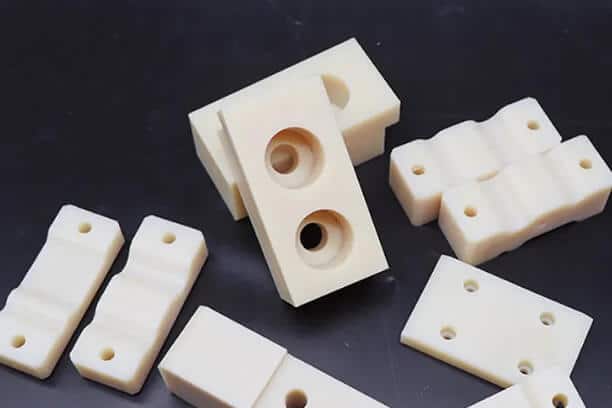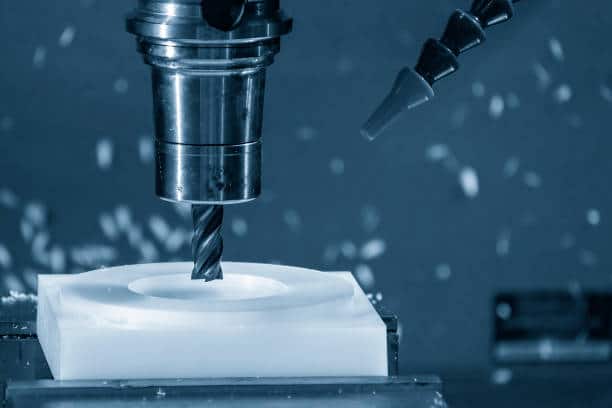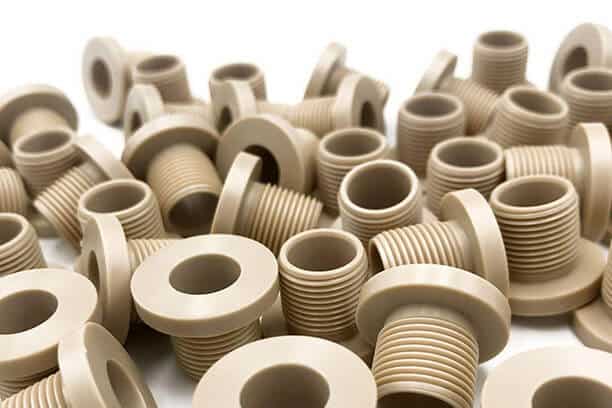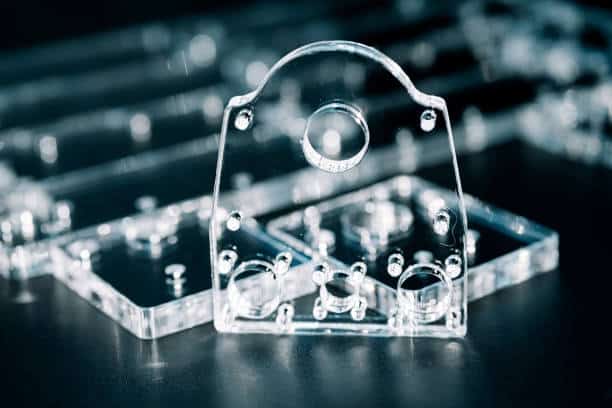Teflon or PTFE stands out from most engineering plastics because of its chemical resistance, stability in high temperatures, and low friction coefficient. As a result, Teflon is a preferred material for CNC machining and milling in industrial applications.
PTFE can be relatively easily machined with CNC machining, but it may be a challenge to maintain high precision. The article offers a basic guide to Teflon CNC machining. It talks about the material properties, benefits, and applications of Teflon parts, and extensively discusses considerations and available machining processes for machining Teflon.
Overview of Teflon
What Is Teflon/PTFE?
Polytetrafluoroethylene, short for PTFE, commonly known by its trademark name Teflon, is a thermoplastic fluoropolymer with a white solid appearance at room temperature. Its chemical composition consists solely of carbon and fluorine, resulting in a hydrophobic and non-reactive material due to the presence of strong bonds between the two elements, among the strongest existing in organic chemistry. PTFE is resistant to various chemicals, including alkalis and acids. Its melting point is 327 °C, and it boasts exceptional toughness, strength, and self-lubrication at low temperatures, with a low friction coefficient. Industries such as automotive and medical benefit from these impressive properties.
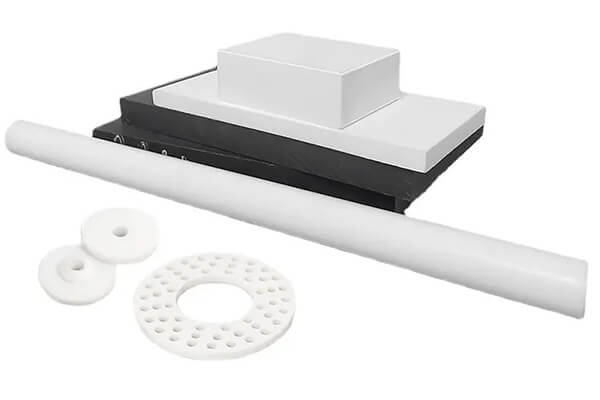
Properties of Teflon
Teflon, or PTFE, is commonly used in a multitude of industries due to its exceptional properties, which stem from its nature as a fluoropolymer thermoplastic. Some of the attributes that make PTFE machined parts so advantageous include:
- Teflon is a thermoplastic with a semi-crystalline structure.
- It has outstanding thermal and electric stability.
- It offers water resistance and low flammability.
- Safe for food contact, PTFE must not corrode, well-suited for cookware and other food-related applications.
- Combining Teflon with carbon or glass can improve its mechanical properties.
- PTFE is widely used in high-temperature and harsh environments due to high resistance to wear, abrasion, fatigue, UV radiation, and chemicals.
- PTFE exhibits self-lubrication properties with a low coefficient of friction.
- Teflon has good machinability.
- PTFE can operate continuously over a broad temperature range, from -100 to 400 degrees Fahrenheit.
Common Grades of Teflon
PTFE that is not filled with additives is chemically inert and offers the best physical and electrical insulation properties of other Teflon types. Mechanical grade PTFE is usually composed of reground PTFE, providing a cost-effective alternative for industries that don’t need high-purity materials. It also offers superior compressive strength and wear resistance compared to pure Teflon.
Teflon (PTFE) is frequently added to various base polymers as an additive to improve mechanical properties such as higher resistance to friction and wear. Different modified PTFE materials are available, most of them offering significantly lower deformation percentages when subjected to high load and a lower friction coefficient. These modified grades may have proprietary names, but all of them have distinct characteristics. Common Teflon polymers used in plastic fabrication are as follows:
- Virgin or pure PTFE boasts excellent chemical resistance, electrical properties, and flexural properties.
- Pigmented PTFE offers better visibility.
- Chemically Modified PTFE provides a smooth surface, improved permeation resistance, and reduced creep properties.
- Glass-filled PTFE is ideal for applications that require excellent resistance to chemicals and wear and high compressive strength.
- PEEK-filled PTFE is valued for its exceptional compressive strength.
Considerations For Machining Teflon
When designing Teflon components, it’s crucial to consider the unique properties of PTFE as behaves differently than traditional machinable thermoplastics. Nonetheless, Teflon is a viable option for various parts and components if the designer and machinist take the necessary precautions and care.
Achieving a tolerance of approximately 0.13mm for Teflon parts is feasible; however, creating tighter tolerances may be challenging without the prior stress-relieving the material. Below are a few essential points to take into account when working with PTFE:
1. Poor rigidity
As a soft thermoplastic, PTFE is relatively easy to machine. However, due to its poor rigidity, the material is vulnerable to tool chatter during machining. To solve this, it’s feasible to introduce reinforcing materials or use a higher-grade Teflon material.
2. Deformation in excessive stress
It’s essential to consider the potential deformation of Teflon material under excessive stress during the machining process. Besides, customizing the part design by eliminating complicated features and tight tolerances may be helpful for the suitability of the material.
3. Parts geometry
The fabrication of unbalanced Teflon parts such as disc-shaped or bow-shaped components is not recommended due to the material’s softness and the significant heat generation resulting from the machining process.
4. Tolerance requirement
Due to its high expansion coefficient and increased stress creep, achieving tight tolerances during Teflon machining is challenging. However, using coolants can help achieve optimal tolerance and surface finish.
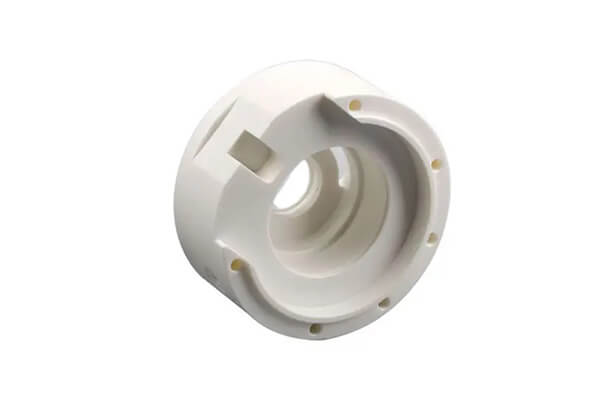
5. Cutting tools
To achieve optimal surface finishes and tolerances when CNC machining Teflon, the use of a cemented carbide tool with a polished top surface, combined with water-soluble coolants like spray mists and pressurized air, is recommended.
6. Generated heat
Same as other manufacturing processes, CNC machining produces heat because of tool movement, so a cooling system must be in place to regulate the generated heat during the Teflon machining process. Teflon is vulnerable to heat, and defects such as warping can occur if there is no cooling system.
7. Surface finish
Deburring is an essential factor to consider when machining Teflon due to its softness. Despite using fine, sharp cutting tools, there is a risk of undesirable marks that require post-processing treatment.
Common surface finishing methods like bead blasting can be utilized to remove irregularities and get a smoother surface for the Teflon part. Furthermore, there is an advanced technique involving freezing the machined Teflon to reduce its softness during the deburring process.
Available Processes For Machining Teflon/PTFE
Multiple machining processes are available to customize Teflon parts. Presented below are common methods to enhance efficiency.
Manual Machining
This machining process does not employ computerized control, leading to a lower degree of accuracy and precision. These processes are, however, suitable for creating PTFE parts that do not necessitate complex designs or tight tolerance. In most cases, DIY projects prefer this type of machining technique.
CNC Machining
The most widely used method for creating custom PTFE machined parts is CNC machining. This subtractive process involves using computer-controlled tools to eliminate portions of the Teflon material to produce the desired component. Techniques employed in PTFE machining include the following:
- CNC milling machines can rotate and travel along multiple axes, creating Teflon parts with high accuracy and precision. This machining method is ideal for producing Teflon parts with rough edges.
- The workpiece is held and rotated while being fed into the CNC turning machine, resulting in the creation of PTFE components with hollow shapes.
- Multi-axis or 5-axis machining is an advanced technique for Teflon machining that allows for making complexly customized parts. It employs a multi-axis and multi-tool configuration to enhance the precision of the final product.
- CNC drilling is a process to make a hole in the Teflon component by use of a drill. Various factors must be considered when using CNC drilling bits such as ensuring that the shaft enables proper evacuation and that the drill is perpendicular to the workpiece to reduce drifting.
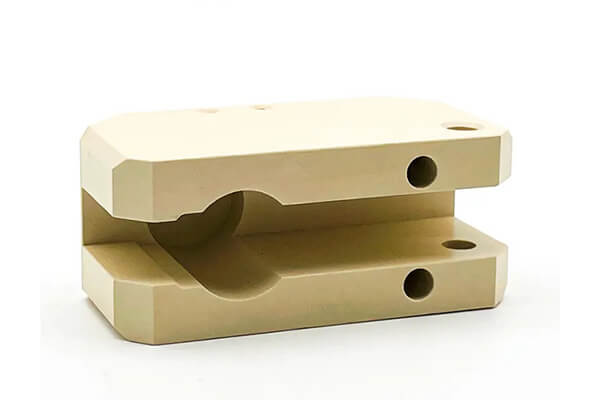
Benefits of CNC Machining Teflon Parts
The advantages of Teflon CNC machining can be divided into those that stem from the inherent material properties of PTFE and those that arise from the machining process itself.
Higher accuracy
CNC machines work independently, so there are fewer errors than with human operators. It also has lower defect rates and is highly repeatable without changes to CNC programming.
Complexity
The ability of CNC machining, particularly machines with multi-axis functions, allows it to precisely create intricate parts, making it a prominent method for precision Teflon machining.
Stability
PTFE is heat-sensitive in its high-temperature amorphous state and has a high viscosity when melted, easily decomposed before melting. Moreover, above 250°C, toxic gases emitted from Teflon may damage operators and consumers. As a result, high-temperature methods like 3D printing and injection molding are not suitable for processing it.
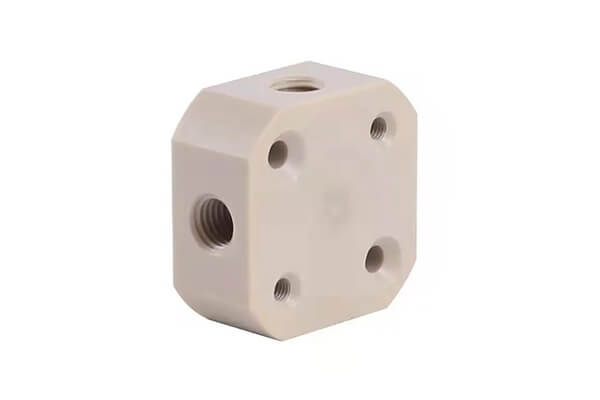
Alternatives to Teflon
For practical or budgetary reasons, substitute materials can be used in place of Teflon for certain projects.
- PCTFE, or Polychlorotrifluoroethylene, is a chlorofluoropolymer thermoplastic, similar to PTFE. It boasts an extraordinary level of water resistance, offering the lowest water vapor transmission rate of any plastic.
- ECTFE, short for Ethylene chlorotrifluoroethylene, is a semi-crystalline fluoropolymer and ethylene and chlorotrifluoroethylene copolymer. Compared to Teflon, ECTFE offers slightly superior chemical and corrosion resistance.
- PFA, or Perfluoroalkoxy, is another type of fluoropolymer with properties similar to PTFE. While it’s not frequently used as Teflon with less rigidity and abrasion resistance, PFA has better non-stick properties, Thus, PFA is more suitable for anti-adhesive applications.
Application Areas of CNC Machined PTFE Parts
CNC machined Teflon or PTFE parts are extensively applicable in a variety of industries due to their useful properties such as thermal stability and low friction coefficient. Teflon in its solid form can be effectively machined through CNC machining. This allows for the creation of industrial components like valves, gears, bushings, and fittings.
Various industries rely on CNC machining to create PTFE parts. Some of those parts include:
- Seals
- Gears
- Gaskets
- Fittings
- Bushings
- Washers
- Spacers
- O-rings
- Insulators
- Bearings
- Manifolds
- Valve components
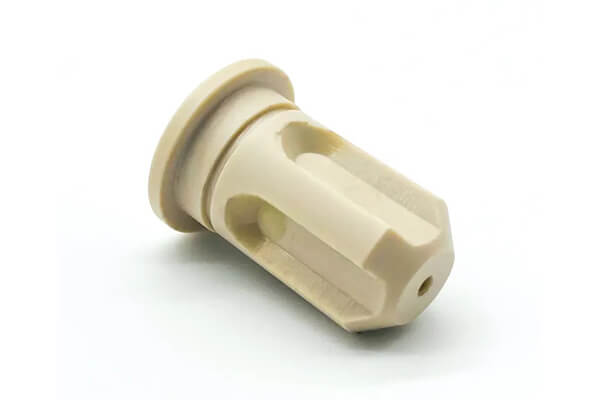
Machining Teflon has been commonly used in various industries to manufacture components with high performance, including:
Aerospace
The aerospace manufacturing industry benefits from using Teflon machine parts because of their mechanical properties like strength and low friction. CNC machining allows for the creation of various Teflon components with high accuracy and flexibility.
Medical
With high chemical inertness and flexibility, Teflon machined parts are extensively used in medical part production. The biocompatibility enables them to retain their structural and chemical stability when implanted in the body. Valves and needle cases are typical medical parts.
Automotive
Machined Teflon parts are utilized in the automotive industry because of their accuracy and precision during the machining process. Gears and valves are some of the typical PTFE applications used in the industry.
Food Processing
The chemical inertness of Teflon makes it an ideal material for food processing, as it does not react negatively with food. Teflon is commonly used in the creation of components for blending food machines.
Custom CNC Machined Teflon/PTFE Parts – Rely On Runsom Precision
With rich years of experience in machining thermoplastics such as PTFE, Runsom Precision is a prototyping expert proficient in offering plastic CNC machining services to fulfill your specific needs. Work with us, and you’ll receive high quality products that meet your expectations. Request an instant quote to start a new project!
Other Articles You May Be Interested in:

